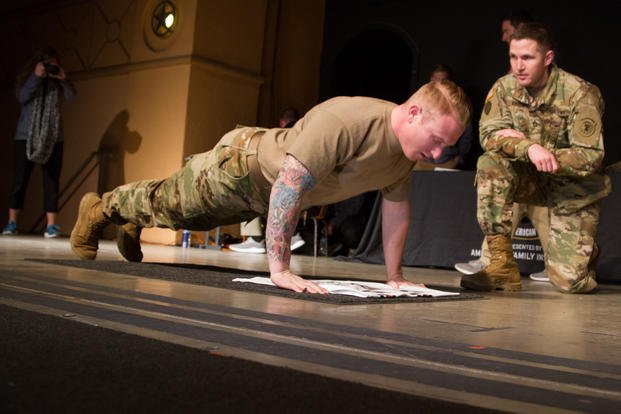This one drives me crazy. Far too often, I see this comment, followed by the question: "Why aren't I getting stronger in my PT?" This question is about adding PT every day into a workout program for hundreds of repetitions each day.
"Stew, I have been doing 500 push-ups and sit-ups, along with 100+ pull-ups every day for the past few months. I saw some great increases, but now my increases have stopped and are starting to turn into decreases on some days I test. What is going on? I thought it was OK to do calisthenics every day?"
Every day -- really? In a row? Is that what you are doing? Not upper body every other day?
This is a great question because I get it all the time, and I am tired of answering it, to be honest.
Now you have inspired a full-length article to clear up what is happening to people who like inventing their own workouts without any regard to recovery or basic physiology. One thing you have to realize is that calisthenics is resistance training, and these specific exercises work the same muscles as some of the most common weight machines or free weights do. Also, consider pull-ups and dips as the heavy-weight version of calisthenics, as you are placing all of your body weight onto these major muscle groups.
Yes you actually can build muscle with calisthenics -- and gain weight, too. So these exercises require rest for you to truly grow, especially at the volume you are doing each day. At 500/500/100+ reps a day, you should only do that every other day max. In fact, I would only get that kind of volume once a week, as you really are taxing your muscles/muscle endurance with this many reps. Here are my weekly recommendations:
First upper-body workout of the week (Monday): Sub-max effort reps so do not fail at any sets. If you think you are going to fail, stop 1-2 reps before that feeling of failure. You still can do several sets and get a pretty high volume of reps, and failing each time is up to you as it is not necessary every set. I like a Super Set Circuit for this type of workout. For instance, do 10-15 sets of 5-10 pullups/dips and 10-20 pushups per set. Rest a minute with a water break/light stretch or active rest, with a set of abs of your choice.
Second upper-body workout of the week (Wednesday): Pyramid workout. This workout has a warmup, max out (one set) and a cooldown built in. It works really well at building and maintaining a foundation of PT fitness for testing or training purposes. See the Pyramid Workout.
Third upper-body workout of the week (Saturday): Notice the two-day recovery for this once-a-week, max failure set workout. Here is a tough workout that will help those stuck at 15+ pull-ups/80+ push-ups get into the 20+/100+ range in a two-minute time period for the physical screening test (PST), physical ability and stamina test (PAST) and physical fitness test (PFT) purposes. Do a set number like 100 pull-ups, 200 push-ups and 300 sit-ups in a max rep set round-robin circuit.
Your goal is to get the 100, 200, 300 in as few sets as possible, resting one minute after each max rep set of pull-ups, push-ups and sit-ups (two-minute max time on each). Your goal is also to fail at each set or make the time limit of two minutes.
So for more information about the three heavy weights of calisthenics (pull-ups, push-ups, dips), check out why it is important to learn about recovery as these exercises work you harder than you think.
Pull-ups will work the grip, back and biceps, just as pulldowns, bent-over rows and biceps curls will. Pull-ups are equivalent to nearly 100% of your body weight on your back and biceps muscles -- and all of your body weight on your grip muscles.
Dips are the same tough heavy-weight exercise as pull-ups but focus the muscle groups of the chest, shoulders and triceps at nearly 100% of your body weight. This is very similar to doing body-weight bench presses or even military presses as far as muscle stresses. These exercises are considered the heavy lifting exercises of the calisthenics world and require rest for recovery.
Push-ups actually will put only about 40%-50% of your body weight on your chest, shoulders and triceps so it is less of a heavy-weight exercise equivalent. But it still requires the same amount of rest as you would need during a weight-lifting day of bench press, military press and other pushing exercises.
Hope this helps you create better workouts that will allow you to recover. Because if you do not recover from your workouts, you will not grow or get stronger.
Note: There is one way I teach daily pull-ups and push-ups in my pull-up-push-workout and my push-up-push-workout.
But here is the difference: These programs only last 10 days of daily push-ups or pull-ups. Then you rest three days, and you test on day 14. Your maxes usually increase by 50%-100% depending on what you started with on day 1. I only recommend these two programs one or two times a year; people who have tried it back to back to back were disappointed with results of any time longer than 10 days.
Stew Smith is a former Navy SEAL and fitness author certified as a Strength and Conditioning Specialist (CSCS) with the National Strength and Conditioning Association. Visit his Fitness eBook store if you're looking to start a workout program to create a healthy lifestyle. Send your fitness questions to stew@stewsmith.com.
Want to Learn More About Military Life?
Whether you're thinking of joining the military, looking for fitness and basic training tips, or keeping up with military life and benefits, Military.com has you covered. Subscribe to Military.com to have military news, updates and resources delivered directly to your inbox.


















